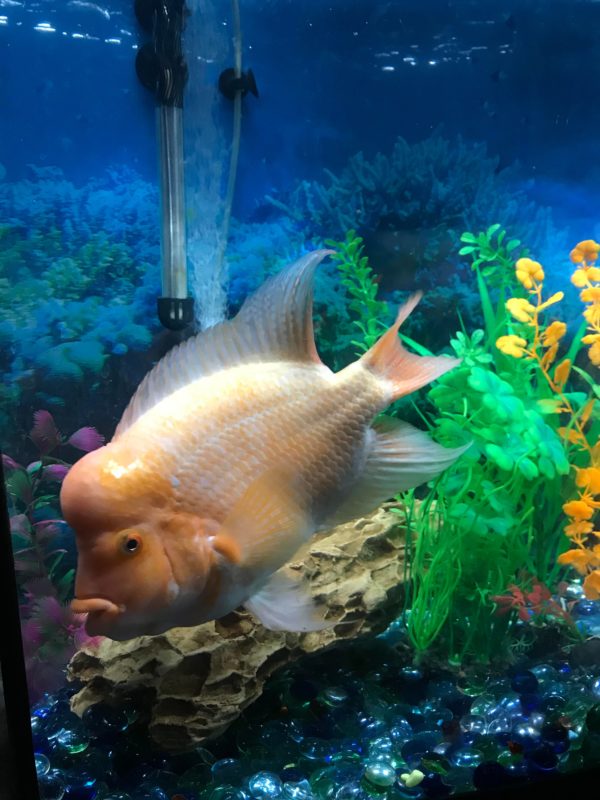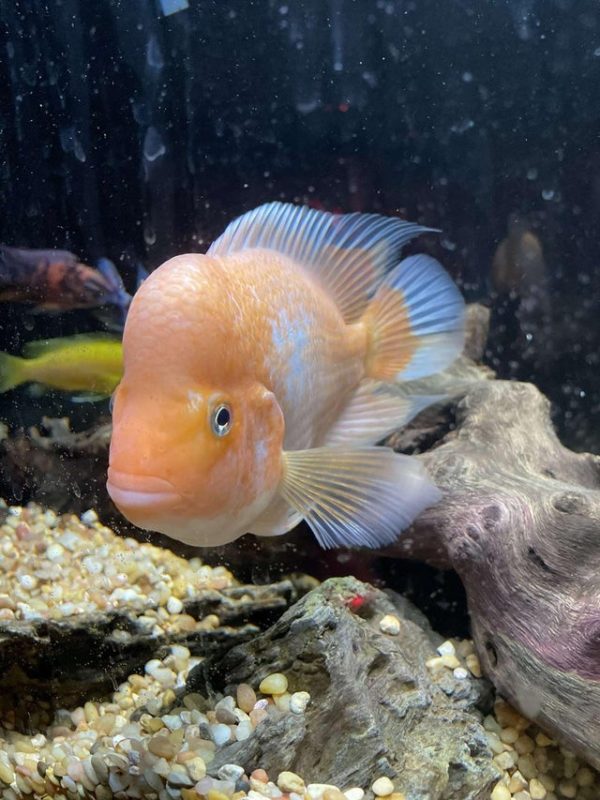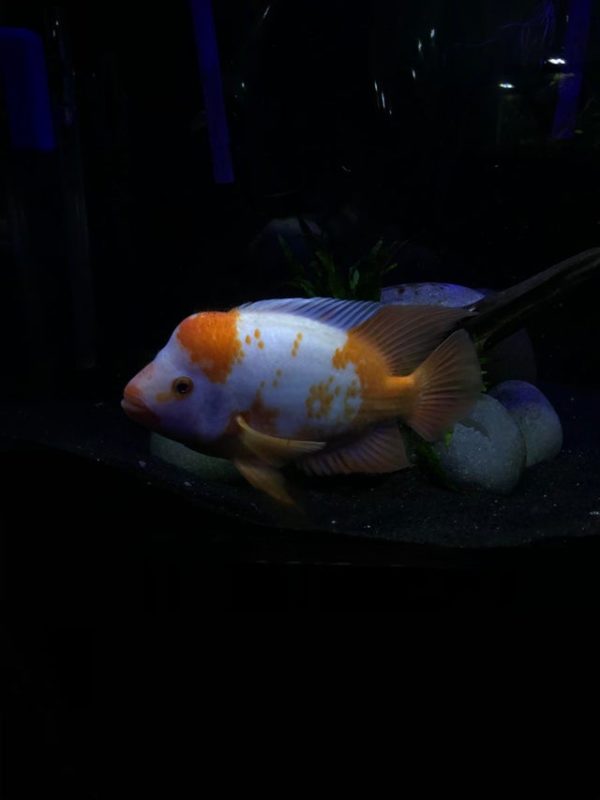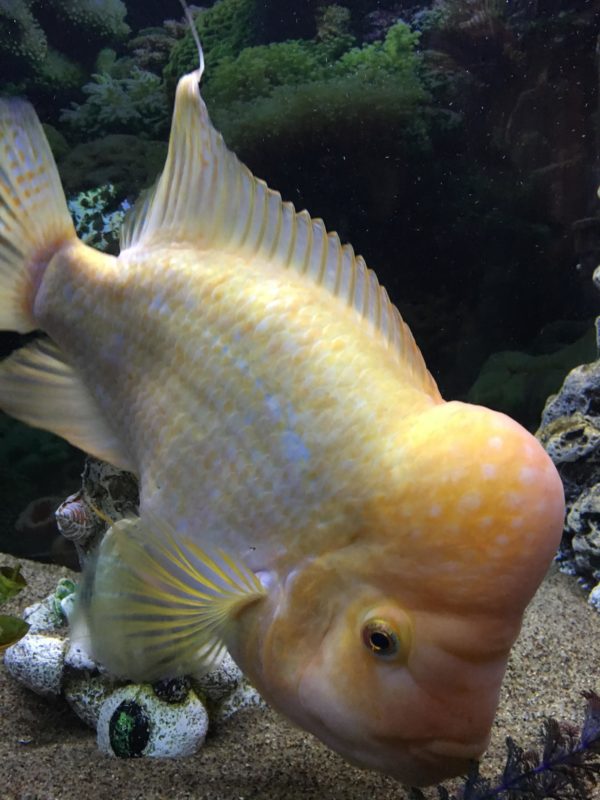Table of Contents
Red Devil Cichid : A Summary
The Red Devil Cichlid is a large freshwater fish native to Central America known for its bright red color and territorial nature. It can grow up to 12 inches in length and has a lifespan of up to 15 years. It should only be kept with similarly sized fishes due to its aggressive streak and it is not recommended for beginner aquarists.
Red Devil Cichlid Overview
To an aquarium enthusiast, rearing a wide range of fishes is often more than just a glorified hobby. Red Devil Cichlid is one such fish that is a very vibrant addition to your tank.
It is a freshwater fish native to the lakes of Nicaragua and is very playful and makes for a colorful addition to your aquarium.
| Information Chart | Red Devil Cichlid | |
| Scientific Name: | Amphilophus labiatus | |
| Family: | Cichlidae | |
| Care Level: | Moderate | |
| Temperament: | Moderate to High Aggressiveness | |
| Color: | Brown or Grey; Sometimes vibrant | |
| Lifespan: | 10-12 years in captivity | |
| Size: | 15 inches fully grown | |
| Diet: | Omnivorous | |
| Minimum Tank Size: | 55 Gallons | |
| Temperature: | 75-79 Degrees Fahrenheit | |
| Water Conditions: | pH level – 6.5 to 7.5Hardness – 6 to 25 dGH | |
| Tank Mate Compatibility | Attacks other fishes and open tank equipment |
Red Devil Cichlid Appearance

Variations of the Red Devil Cichlid have been known to vary widely through the spectrum of colors. They are mostly found in nature bearing the colors grey and green. But it is not uncommon for them to be vividly colored like red, pink, and white. Some species of the fish have black streaks across their body or are exclusively covered with black bands and spots of their fins and the fan-like tail.
There is, however, a slight distinction one can make between the Red Devil Cichlid found in the wild when compared to the ones that are bred in captivity. The Red Devil Cichlid that is found in the wild sometimes has larger black lips.
Lifespan of Red Devil Cichlid
The typical lifespan of a Red Devil Cichlid is 10 to 12 years.
The average life of this fish is 12 years but this timeline is not set in stone. A Red Devil Cichlid is known to live longer under proper care and an optimal tank environment.
Red Devil Cichlid Size
The Red Devil Cichlid typically grows up to 10-14 inches on the lower end and 15 inches for larger specimens.
This fish grows fully to a lanky 15 inches on average. This size variant makes the Red Devil Cichlid a rather large freshwater fish to be bred in a tank. There is all but a slight variation between the genders in this fish, the male being a tad bit longer than their female counterparts.
Natural Habitat and Origin of the Red Devil Cichlid
The Red Devil Cichlid is native to two freshwater lakes, Lake Managua and Lake Nicaragua in Nicaragua situated in Central America. Its scientific name is Amphilophus labiatus and was originally classified as Cichlasoma labiatum in 1864 by the celebrated zoologist Albert Gunther. The Red Devil Cichlid is rarely found in flowing rivers and is found in freshwater lakes. In the wild, the Red Devil lurks around in open waters and prefers a landscape surrounded by rocks which serve as a quick hiding place in case of an attack by a bigger fish. In the tank, however, owing to its size and teeth, the Red Devil Cichlid turns predator showing its aggression at the smaller fishes.
Red Devil Cichlid Care & Tank Set-Up
Red Devil Cichlid Tank Size and Specifications
Since the Red Devil Cichlid is a temperamental fish, it requires certain set parameters to be taken care of when you bring them home as a pet.

Optimum Tank Size for Red Devil Cichlid
The recommended tank size for Red Devil Cichlid is a minimum capacity of 55 gallons.
If you plan on rearing one fish from this species, it is highly recommended to house a fish tank that has the capacity to hold 55 gallons of water i.e, 208 liters. If you plan on having a breeding pair of the red devils, then 125 gallons (473 liters) is ideally suggested. The Red Devil Cichlid grow to much bigger sizes as compared to the regular tank fishes so getting them cramped in smaller tanks is not advisable.
Filter Type
The suggested filter setup for a tank that houses the Red Devil Cichlid is a dual filter setup. The tank needs to have a slow yet consistent water movement for the fish to thrive well. As for the traditional canister filter setup with an attached sump, it can also be used.
Substrate
The Red Devil Cichlid is known to wreak havoc in the tank setup as they generally have the tendency to be voracious diggers and biters. Since this fish loves to dig, fine sand is usually advised to be put on the bed on the tank since gravel or rocky substrate will hurt them. As for the plants, it is advised against using them. Placing larger rocks on the bed is also a good idea as they provide crevices for the fish to hide to help mimic their behavior in the wild.
How many Red Devil Cichlids in a 200 gallon tank?
In the case of housing a school of these freshwater fighters, the tank should be at a full capacity of 200 gallons or more. These freshwater fishes need a lot of space to swim around.
Water Parameters for Red Devil Cichlid
Water Temperature
The ideal water temperature for a Red Devil Cichlid is 75to 79 degrees Fahrenheit
pH Level
The perfect water pH level for a Red Devil Cichlid is 6.5 to 7.5
Water Hardness
The ideal water hardness level to be maintained for a Red Devil Cichlid is 6 to 25 dGH.
Red Devil Cichlid Tank Landscape

Red Devil Cichlid is a feisty fish and so setting up the tank for its habitation can be quite the task. They have the tendency to dig and shovel the substrate and so a very specific set of landscapes works well for them
Plants for Red Devil Cichlid Tanks
It is strongly advised to not add any plants to the tank that houses these fishes as they tend to uproot them easily when they dig. The Red Devil Cichlid is also notorious for biting at the herbage.
Decorations for Red Devil Cichlid Tanks
Oxygenated airstones also make for a handy addition in the tank as they keep the oxygen levels high in the tank which helps the Red Devil Cichlid retain their natural vibrant color.
Lighting for Red Devil Cichlid Tanks
The Red Devil Cichlid needs natural lighting to thrive so it is suggested to keep the tank moderately lit with nothing flashy.
All the equipment additions that are to be made to their tank need to be discreet and the wires well-hidden because the Red Devil will devour its way through any exposed frail wires or landscaping. If you want to add rocks and wood to the tank landscape, make sure it is safely anchored to the bed of the tank. Also, keep a lot of wiggle room for the fish to swim in the tank.

Feeding Red Devil Cichlid
Best Diet for Red Devil Cichlid
The dietary requirements of the Red Devil are quite varied as they are omnivorous by nature. Since it is a predatory fish, it thrives on a good amount of protein that is derived from meaty sources. But it also heavily relies on vegetables for maximum nutritional benefits.
Feeding a Red Devil Cichlid is to strike an optimum balance between dry frozen foods and live foods while offering heavy mammal-based meats only rarely.
One can start off small by feeding the fish if they are a little apprehensive. Cichlid pellets and fish flakes make for the perfect diet in the initial days of their care. As time progresses, the following food items are perfect for feeding the Red Devil Cichlid: Bloodworms, crickets, earthworms, shrimp, and spirulina. Other food items that can be occasionally fed to the Red Devil Cichlid are chicken and red meat variations as a treat.
How often should you feed Red Devil Cichlid?
Red Devil Cichlid should typically be fed several times a day in small batches.
Red Devil Cichlid Behaviour and Temperament

Is Red Devil Cichlid lone or societal in nature?
Although the Red Devil Cichlid is an aggressive fish by nature, it is charming and quite possessive of its owner. They are energetic and charismatic enough to hold the attention of their owners but are extremely wary of other fishes, even if they are from the same species.
Red Devil Cichlid Tank Mates
Red Devil Cichlids are highly territorial in nature so if you are planning to get one of them as a pet, be prepared to have an entire tank dedicated to them. There is a chance that the younger Red Devils do take to cohabitation comfortably but there is a good possibility that their social tendency to be aggressive may flare up when they are older.
Red Devil Cichlid is a fish that is constantly on the move so it is advisable to have a large tank in place for it to thrive. To ease their aggression, one can make full use of the tank landscaping and provide a lot of good hiding spots and dark corners for the red devil to feel safe. All of the add-ons anchored safely to the bed of the tank, of course.
Breeding Red Devil Cichlid
The Red Devil Cichlid is monogamous in nature and owing to this nature of the fishes; it is fairly easy to breed them in captivity especially for beginners.
To begin the breeding process, it is advised to raise the water temperature so that it resembles the conditions of the breeding season in the wild water. To that end, the temperature of the water in the tank is raised to a warm 77 degrees Fahrenheit. It is also essential that a nutritious diet is given to the fish at this time.
When the female is ready to lay eggs, she looks for an inclined surface or a flat area on the substrate. She lays about 600 to 700 eggs at once and they look slightly pale and are yellowish-orange on the outside. After the eggs are hatched, the male fertilizes them and they hatch in about 3 to 4 days.
Both the male and female fishes take care of the fry. While they are young, the fry feeds off the skin of their parents before feeding on small food independently over time.
Red Devil Cichlid Breeding Level – Easy
Red Devil Cichlid Sexual Dimorphism?
To distinguish between males and females, it is essential to keep track of their overall size and the size of the nuchal hump.
The male counterparts are more largely built and have spectacular nuchal humps on their heads that mostly flare up during the breeding season.
Red Devil Cichlid Common Diseases and their Treatment
Since the red devil cichlid is a freshwater fish, it is at the risk of contracting certain infections if the quality and hygiene of the water in the tank is not maintained.

Hole-in-the-head disease
As the name suggests, in this disease the fish actually develops holes on the head and the face. There is also evidence that suggests that this disease can be caused by nutritional deficiencies in the diet. Hence, keeping the water hardness level balanced and providing a diet that is nutrient-rich is essential to prevent this disease.
One must also keep an eye out for parasitic attacks, bacterial infections, and fungal infections. Most of these conditions can be prevented if the water conditions in the tank are clean and stress-free. Providing the Red Devils with proper hiding spaces in the tank along with a lot of room to swim around also helps them thrive.
Facts about Red Devil Cichlid
- Red Devil Cichlids form bonds with their owners. Just like dogs, they beg for their food and are extremely playful.
- Red Devils are very aggressive and like to bite off anything that comes in their way, quite literally. They are known to bite off equipment wires if they are in the open in the tank.
- They populate most freshwater lakes of the Central American country, Nicaragua.
- Red Devils thrive compulsively in hygienic water conditions. So cleaning the tank regularly and filtering out the excreta is of utmost importance for their well-being.
- Smaller tanks and restricted environments can make them crabby and shorten their lifespan.
Are Red Devil Cichlids Right For You?
One cannot impress enough on the charming nature of the Red Devil Cichlid. They can be hostile towards the other fishes, but they are extremely charismatic as pets. Most aquarists claim that the Red Devil Cichlid is one of their favorite freshwater fishes to rear.

1 thought on “Red Devil Cichlid: Complete Guide to Care, Breeding, Tank Size and Disease”
I have a red devil and a red Oscar in an 80 gallon tank. They are both adults. Bought them both around the same time but from different stores. They were both about the size of a quarter at the time of purchase. Also purchased a black pleco of similar size where the Oscar was purchased. All 3 are very beautiful. No scars or marks on them from fighting. But on occasion they do appear to be in conflict with one another. However none of them appears to be more aggressive than the other two. They seem to just have their day occasionally. These 3 have been sharing this 80 gal aquarium for approximately 6-7 yrs now without a problem. So are we past the point where I need red to worry that one day the aggression will spike on the part of the red devil and it hurt the Oscar? Is there any way to send you a pic of my fish. They really are quite beautiful and big!